Posts Tagged ‘Attractors’
{{start}}
More often than not I include an attractor pattern in my team of flies. If I am retrieving my flies fast I generally use one of the bigger attractors such as a fat boy or blob and fish that on the top dropper so that is the first fly fish see as my team is ripped through holding water. Hopefully that gets their attention and whilst they may not close on that attractor it does put them in a position where they may see and take the otherwise less obvious following flies. If I am fishing static or slow I prefer my attractor, generally a squirmy wormy or blob to be on the point so that fish see that. If they don’t want that fly the theory is that fish may be inquisitive enough to have a closer look at it and then may swim up and investigate your other offerings. If I am prospecting and using a range of retrieves from slow to fast I generally prefer a smaller attractor such as a the dunkeld or a tiny blob or even a small slightly flashy bugger or damsel on the middle dropper.
{{end}}
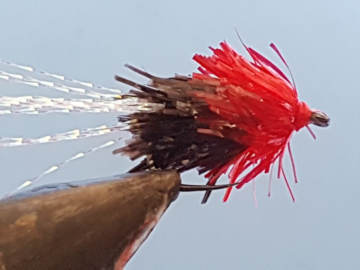
{{+1}}Bibio blob{{-1}}
{{start}}
One of my favourite flies for waters where there is midge activity is the bibio and when I am fishing those waters most of the time I have a bibio on the top dropper. This blob is fast becoming a go to alternative to a bibio for me.{{end}}
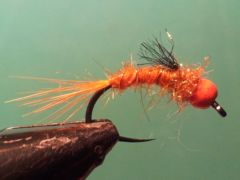
{{+1}}Carrot wet fly{{-1}}
{{start}}
This fly came about as an extension of the idea of using very popular carrot dry fly and has turned out to be a great weighted attractor fly to use on the top or middle dropper when fishing a representation fly on the point to river fish.{{end}}
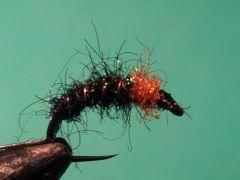
{{+1}}Tiger midge{{-1}}
{{start}}
This is a great dropper fly in lakes where there are populations of midge and my good mate Peter Walsh, who first came up with particular tie, fishes it with plenty of confidence and results. It's a lot like my Bibio variant except that the dominant colours are black and orange as apposed to back and red and it is tied without a front hackle.{{end}}

{{+1}}Sparkler{{-1}}
{{start}}
When a seriously flashy fly is needed because of visibility or you just need a fly to excite fish this fly may save the day.{{end}}
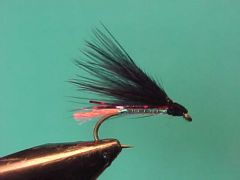
{{+1}}Cormorant – black attractor variant{{-1}}
{{start}}
This is my favourite attractor version of a cormorant for loch style fishing in waters where trout are switched onto black flies.{{end}}
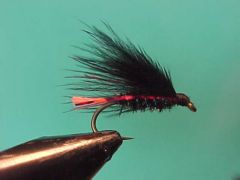
{{+1}}Cormorant – variant to the original tie{{-1}}
{{start}}
I carry black and olive versions of this fly. A simple to tie fly that incorporates two of the greatest fly tying materials, marabou and peacock herl and it continues to be a popular single or team fly. It's also a fly that has lent itself to adaptation and you will often come across versions with glass or brass bead heads, bodies of all sorts of tinsels and colours and wings in a range of marabou colours. These days the cormorant and its many variations are fished in all sorts of ways from almost static right up to roly poly on a full range of fly lines.{{end}}
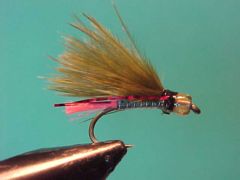
{{+1}}Cormorant – BH competition version{{-1}}
{{start}}
The cormorant fly is a popular loch fly and particularly in rainbow trout waters. The original tie has a peacock herl body with silver rib whereas this competition version has been jazzed up a bit by substituting clear holographic tinsel for the herl body.{{end}}
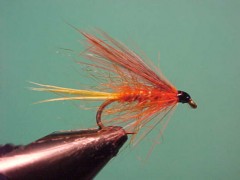
{{+1}}Dunkeld – Chatto’s fuzzeled variant{{-1}}
{{start}}
The Dunkeld is certainly one of my top 5 middle dropper flies for lock style fly fishing. Until 18 months ago I was using a version of the Dunkeld that had a hackle Palmered along the body as in the original. At that time I was experimenting with "fuzzeled" bodies an an alternative to bodies with a Palmered hackle and applied that technique to this fly with immediate success.{{end}}
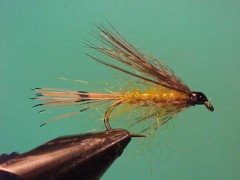
{{+1}}Bredbo variant MK2 – Chatto’s original{{-1}}
{{start}}
The MK2 is a great alternative middle dropper lock fly to my tie of a Dunkeld for those bright full sun days and also a very formidable wee wet for faster or discoloured rivers.{{end}}
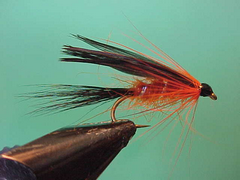
{{+1}}Scotch Poacher{{-1}}
{{start}}
A New Zealand fly tied with an overlaid wing and tied as an evening fly to imitate their freshwater crayfish known as Koura. The preferred fishing technique in New Zealand is to fish it slowly along the bottom. It certainly works well when fished that way in Australia but it has also found its way into may Australian Loch fly boxes as a dropper fly for waters where orange is a good trigger colour and mudeyes or yabbies are on the move.{{end}}













